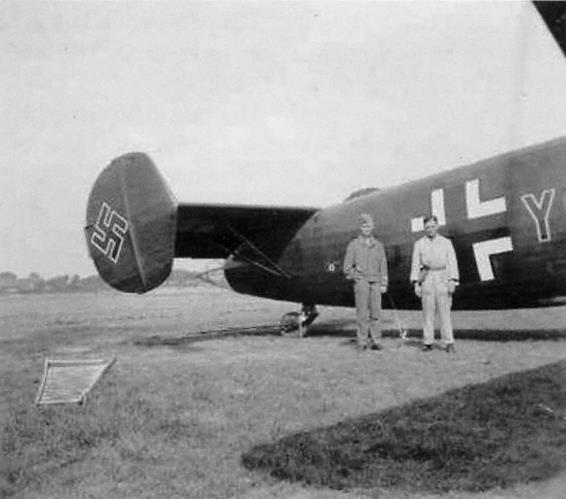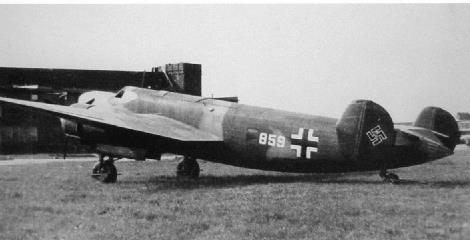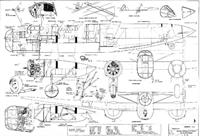


In the early 1930s, the Luchtvaartafdeeling (i.e. the Netherlands Army Air Force) became interested in the luchtkruiser (aerial cruiser) concept multipurpose aircraft, which was have a primary role of intercepting and destroying enemy bomber formations, with a secondary role as a long range bomber, with Colonel P.W. Best, commander of the Luchtvaartafdeeling stating on 28 March 1935 that aircraft of the luchtkruiser should be purchased in as large numbers as possible, proposing to cancel procurement of the Fokker D.XXI fighter to release funds.
To meet this requirement, Fokker developed the T.V, a five-seat, twin-engined monoplane. It featured a wooden wing, while the slab-sided fuselage was of mixed construction, with a wooden monocoque centre fuselage, a fabric covered steel tube rear fuselage and a duralumin forward fuselage. While this construction method was typical for Fokker aircraft, it was obsolete compared with contemporary aircraft of its size, which were normally of all-metal construction. It was fitted with a 20 mm autocannon in the nose to meet the bomber destroyer part of the requirement, and four defensive Browning machine guns, one each in dorsal, ventral and tail positions, with one capable of being switched between two waist positions. It had a bomb-bay under the centre fuselage capable of carrying up to 1,000 kg (2,200 lb) of bombs.
A contract was signed for 16 T.Vs on 7 December 1936,[3] with the first aircraft (not a prototype as such) flying on 16 October 1937 from Schiphol airfield.
The first 11 T.Vs, by now considered medium bombers, were delivered in 1938, with the last 4 following in 1939. Although it had good handling characteristics, its suffered from reliability problems with its engines and propellers, and by the summer of 1939, the Netherlands was planning to purchase 24 Dornier Do 215s to replace them.
On 10 May 1940, Germany invaded the Netherlands, Belgium and Luxembourg. The T.V saw its first combat, when taking off from Schiphol to avoid air attack, eight T.Vs encountered a formation of German bombers, shooting down two. After this, the T.V reverted to its primary bomber role, being used in attacks against German airborne troops landing at The Hague and Rotterdam. By the end of the first day of fighting only two T.Vs were servicible, being sent against bridges over the River Maas at Rotterdam on 11 May, where a further aircraft was shot down, with the final T.V being shot down during attacks on bridges at Moerdijk on 13 May. As the T.V lacked self-sealing fuel tanks, they gained a reputation for rapidly catching fire when hit by enemy fire.
After the capitulation the Germans captured five T.V'sf four of them at Schiphol: 852, 857, 859 en 863. Most likely three were repaired and ferried to Germany, among them 852 and 859. 864, in repair with Fokker, was used for spares. In Summer 1940 the T.V was already flown in Germany. About their use nothing is known. It was rumoured that one had been flown by Junkers, and that one remained in 1944.
| Type |
5-seat bomber (Pilot, co-pilot, bombardier, radioman/gunner, gunner) |
| Engine |
2 Bristol Pegasus XXVI |
| Dimensions |
Length 16,00 m, height 4,20 m, span 21,00 m, wing area 66,2 m2 |
| Weights |
Empty 4650 kg, loaded 7250 kg, max. take-off weight 7650 kg |
| Performance |
Max. speed 417 km/h, cruising speed 335 km/h, service ceiling 8550 m, climb to 5000 m 13,1 min. |
| Armament |
1 20 mm Solothurn S-18/100 cannon in a nose cupola, 4 7,9 mm MG in dorsal, ventral and lateral positions. Bombload 1000 kg |
| Type |
Werk.Nr |
Registration |
History |
|
|
852 |
Ferried to Germany |
|
|
857 |
|
|
|
859 |
Ferried to Germany |
|
|
863 |
|
|
|
864 |
Repaired by Fokker, used as spares |


